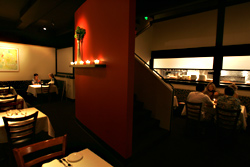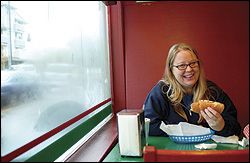On my first visit to Madoka, a sleek new restaurant offering “Pan-Pacific” cuisine on Bainbridge Island, my husband and I snagged a quiet corner booth within sight of the semi-open kitchen. The weekend evening rush hadn’t yet begun, and chef Alvin Binuya stood in front of a long horizontal work surface flanked by two assistants. Mostly, the three men stood there silently, knives poised, waiting for orders to come in. But occasionally I caught them laughing together—quiet and controlled, but clearly enjoying themselves.
That combination of Zen-like calm and playfulness is an apt characterization of Madoka’s menu, too. Binuya, a native of the Philippines who grew up on Vashon Island and formerly headed the kitchens at Ponti Seafood Grill and Belltown’s late Axis, is known as a pioneer of fusion cuisine. That phrase can connote flashy (or outright wacky) juxtapositions of ingredients, but Binuya seems more interested in gently lifting to the surface the hidden connections between different cuisines.
We saw this approach right away with a starter of grilled asparagus—a steal at $5 for an ample plateful of emerald green spears, crunchy with sea salt and tasty charred spots. It came with a citrusy ponzu dipping sauce that was a simple but neat twist on the familiar combination of asparagus and lemon.
Or take the soy sauce salad ($5), which placed the fermented soybean brew in the role usually occupied by a good balsamic vinegar in dressing a salad. I’d never paid much attention to the flavor of soy sauce, but this simple presentation—just mixed greens scattered with pale slivers of cucumber and onion—highlighted its smoky complexities.
Madoka means “the perfect circle” in Japanese, an image that evokes the Pacific Rim from which the menu’s inspiration is drawn. Around here, such inspiration usually means an Asian-inflected take on Pacific Northwest ingredients—and that’s present at Madoka, certainly—but Binuya and manager/co-owner José Gonzales paddle their kayaks farther south than most, incorporating many Latin ingredients as well. In fact, what draws the menu together is an emphasis on smoky flavors, from that soy sauce salad to the abundance of grilled items to all manner of roasted chilies.
In the case of the grilled Columbia River king salmon ($25), for example, the smokiness on the outside recalled the alder- or cedar-plank cooking method traditionally used by Northwest Native American tribes. But this was a modern preparation, the inside of the fish rare like seared tuna (in general, the kitchen tends to err on the rare side when grilling). The flesh was milder than that of the Alaskan salmon I’m used to—does the colder water up north contribute to a stronger taste? Or does this reflect a genetic difference between stocks? Here was a case where careful sourcing was thought-provoking, more than just words on a menu.
Another dish on the large-plates menu, masa-quinoa cakes ($16), offered a chewy and satisfying combination of grains, with a rich stew of tomatoes and black beans on top. Though meatless, this dish was complex and clearly more than an afterthought—an approach that, in combination with the offerings of hormone- and antibiotic-free meats and responsibly sourced seafood, makes Madoka a place where vegetarians and thoughtful carnivores can happily coexist.
A second visit with a friend began with a generous bowl of Penn Cove mussels ($9), robed in a green curry sauce that highlighted the mollusks’ natural sweetness. A floral note—wine, in a nod to the classic French preparation? Or liquor from the mussels?—floated above the unctuous taste of the coconut milk. We picked the tender meat from the shells, and a server happily brought us extra bread—a chewy, tangy sourdough baguette—to sop up the sauce.
The staff at Madoka, in fact, deserves as much praise as the food. On both visits we found the service to be genuine—friendly rather than merely polite, without being affected or overbearing.
A warm Dungeness crab salad ($12) seemed at first to be a less lusty dish than the mussels—a meaty crab cake perched atop a small pile of greens and surrounded by puddles of sunny jalapeño-mango vinaigrette and slices of pickled onion, cucumber, and beet. The arrangement reminded me of a painter’s palette, and I began eating it in a judicious, paint-by-numbers manner—but I wound up a wild fauvist, throwing together every possible combination of taste and color, each one even better than the last.
After these starters, a plate of “bronzed” Alaskan halibut ($26) seemed less innovative. The fish itself was clean-flavored and cooked just to maximum succulence, but the other elements on the plate didn’t measure up to it: rather ordinary tomato-tinged rice and a poblano butter that just tasted fatty.
Deft timing also characterized the pork tenderloin, lean but juicy and subtly flavored. It was served over a mound of fresh linguine tossed in a chili-spiked tomato sauce, which was at once Latin and Italian and which threw our taste buds into a state of pleasant confusion. A bright green puree, sprightly with plenty of lime, rounded out the array of flavors on the plate.
At meal’s end, the pastries on the dessert menu tempted us, but we opted for a summery pair of ice creams. A coconut-ricotta ice cream ($7) had an exceptionally rich texture and tasted also of almonds. It came with a dark, pure chocolate– rum sauce and a spicy ginger shortbread cookie. A cracked-pepper vanilla ice cream ($8)—subtle, with an occasional fleck of spiciness—was served with gorgeously ripe local strawberries that reduced me to uttering idiocies like “strawberry orgasm.” It was a ridiculous thing to say in a place with such a sophisticated menu and beautiful execution. But even diners in serious restaurants, just like serious chefs, have to laugh and horse around sometimes.






